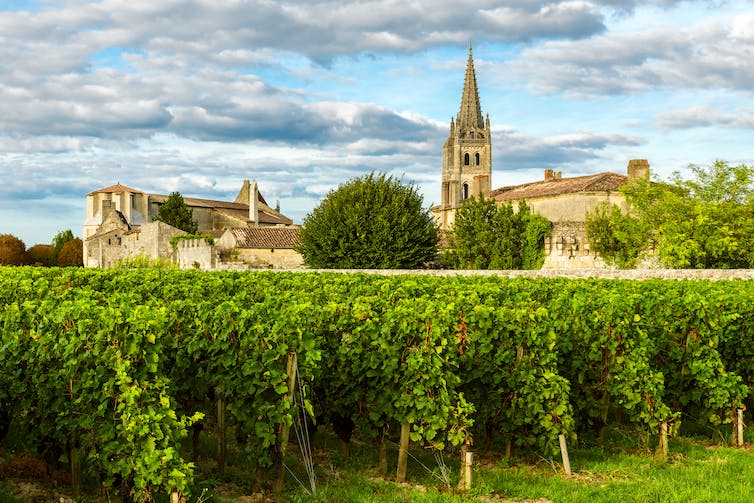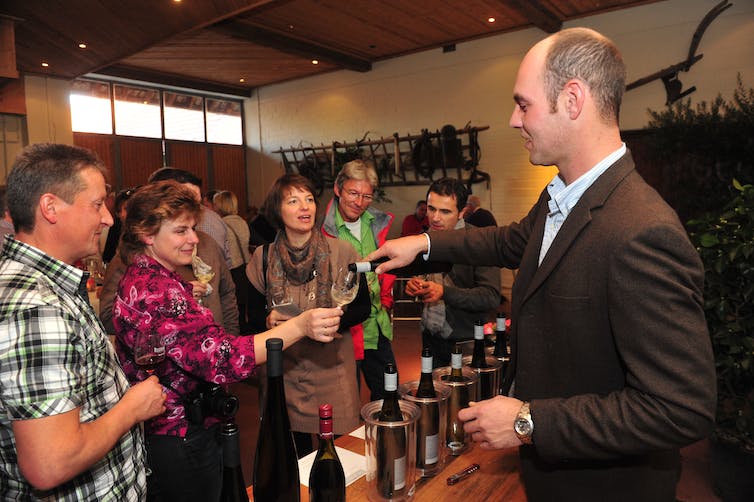Our perception of wine has more to do with its commercial history than we think

Consumers tend to think of wine as a product of culture and authenticity. Because of this, they see it as distinct from other manufactured commercial goods.
As an agricultural product, we think about wine as linked to a place and sometimes to an individual producer. After that it is considered a historical product rooted in the traditions of a region. And finally, wine is treated as an aesthetic product, in a similar way to the arts, with its key consumers, terminology, prominent producers and specific media attention.
But is wine really distinctive?
In 2021, the value of the global wine market was over $53 billion, with global production around 260 million hectolitres, the equivalent of 34 billion bottles. Of this, about half is exported and therefore consumed outside its place of origin. The main producing countries by volume are Italy, France, Spain, the United States and Australia.
Vineyards in Cafayate, Argentina. The South American country has joined the top five wine-producing countries.
(Shutterstock)
Yet wine has been a commercial product for 3,000 years. And paradoxically, many of the cultural ideas which shape how we perceive wine today actually stem from its history as a commercial product.
As an anthropologist and professor in the department of social and public communication at Université du Québec à Montréal (UQAM), I see wine as a cultural object. That is to say, wine carries meanings that are socially constructed and through which both producers and consumers think about it in unconscious ways.
I carried out my first anthropological research fieldwork on wine in Calabria, in southern Italy, in 2000-2001, and have returned there three times. I conducted a second anthropological investigation in British Columbia, in the Okanagan Valley, in 2017-2018. I will present some of the results of this research later in The Conversation.
I am also a wine lover and have been running the website sommeliervirtuel.com with my brother Mathieu for over 10 years. Through this activity we have become recognized as wine influencers in Quebec, and I have been able to deepen my knowledge of the wine market and its consumer culture.
In this first article, I demonstrate how some of our cultural conceptions of wine actually arose from the commercial nature of the product.
The importance of place
A central element of wine is that it is attached to place. We can talk about a Bordeaux, a Burgundy or a Chianti without having to add that we are talking about wine. Yet as far back as ancient Greece, and later in the Middle Ages, it was different elites that created a market for wines from recognized, distant regions.

Tasting a Chianti, in the Chianti region of Tuscany. The name of the region is associated with its flagship product.
(Shutterstock)
At the same time, the wine that was produced and consumed locally had no specific identity and was considered a common agricultural product among others.
It was through trade, especially over long distances, that the place of origin of wines became important and significant.
The utopia of terroir versus the realities of trade
Trade also helps explain why wine production became concentrated in certain regions and not others.
Official speeches (guidebooks, wine books, laws) claim that this is because of the quality of a specific region’s terroir, according to the idea that wine production is concentrated in the places most suitable for quality production. In fact, trade is what explains how vineyards came to be concentrated in certain regions, but not others.
The French geographer and historian Roger Dion has shown how wine production became concentrated in France because of the country’s vanguard position vis-à-vis the markets of northern Europe. He points to how the wine-producing regions were concentrated around rivers, which were essential for the transport of heavy cargoes before the arrival of the train.
So it was actually France’s geographical position that explained the development and historical renown of its wine regions.

Vineyards in Saint-Émilion, France. Wine production would be concentrated in France because of the country’s vanguard position vis-à-vis the markets of northern Europe.
(Shutterstock)
Historically, regions that specialized in wine production were able to do so because they had the possibility of selling their production in other markets. That’s because a peasant family could not subsist on wine. The utopic concept of terroir, however, has been used to conceal these origins, attributing the renown of wines to regions and nature, while, historically, their reputations were actually built through trade.
From agricultural to luxury product
With the development of wine consumer markets in what were then non-producing countries, such as England, Northern Europe and America, a specific conception of wine emerged.
In these markets, wine was not considered an agricultural product. Wine was a luxury product, reserved for certain social groups. Even when wine spread throughout society, it remained a rare and occasional product.

A wine tasting in Worns, Germany. In the northern European and US markets, wine is still an exceptional product, to be drunk on special occasions.
(Shutterstock)
This view of wine remains the dominant one today, even in the wine-producing countries themselves, where the habit of daily wine consumption has yielded to one of occasional consumption.
Bordeaux and the English market
The case of the Bordeaux region is instructive and has played a key role in the development of several contemporary notions of wine.
The Bordeaux vineyard developed in response to demand from the English and Dutch markets, which, in turn, controlled the region and its trade starting in the 17th century. In this context, it was the English market that drove consumers and merchants to pay specific attention to vintages, as well as growths, and the crus of Bordeaux, that is to say the “Châteaux,” such as Ho Bryan (Haut-Brion) or Margose Wine (Margaux) whose first mentions are in English.

Château and vineyard in Margaux, in the Bordeaux region. The Bordeaux vineyard developed in response to demand from the English and Dutch, who in turn controlled the region and its trade starting in the 17th century.
(Shutterstock)
The famous classification of Bordeaux wines of 1855, still in force today, was created at the universal exhibition in Paris on the basis of wine prices that were established by the English market.
The emergence of new consumer markets, particularly in Asia, is now putting upward pressure on the wine market and driving up the prices of specific wines from the most sought-after areas or regions. At the same time, China has started to produce and export its own wine, increasing the already strong competition between different wine-producing regions of the world.

A shelf full of wine bottles in a supermarket in Shanghai, China. The country has started producing and exporting wine.
(Shutterstock)
In Asian markets, wine remains a prestige product, especially as a gift, for example in Japan. If the conceptions of wine so far are mainly Western, perhaps the Asian markets will influence the way we think about wine in the medium or long term.
These are just a few examples of how the commercial nature of wine, through its long history, has influenced our perception of the product. Is wine perhaps hiding its true nature behind the rhetoric of its authenticity? Because objectively, wine is only fermented grape juice.







